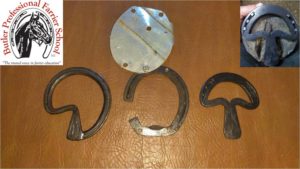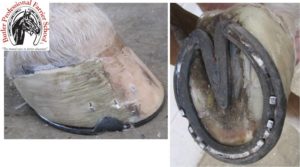Three-Quarter Shoes
This past weekend (9 June 2018), Justify won the Belmont Stakes, making him only the 13th horse in history to become a Triple Crown Winner! This was an impressive feat considering some obstacles Justify had to overcome in order to achieve this great milestone.
The Kentucky Derby (the first race of the Triple Crown) was wet and muddy. Justify seemed to have no problem navigating the sloppy conditions but he seemed to pick up a minor lameness issue in his left hind foot. Trainer, Bob Baffert said, “Any time you run horses on a wet track, it’s very abrasive, especially that day. It burns their heels and that’s when bruised feet come out…we deal with these issues constantly in horse racing…” According to Baffert, they began to treat the bruise right away medically. They alleviated pressure to the area by having the farrier apply a three-quarter (3/4) shoe. He trained for a short period of time in this shoe before returning to a full shoe, with Equilox, before the Preakness Stakes.
What is a Three-Quarter Shoe?
Three-quarter shoes have been used for a long time by farriers and veterinarians to help horses afflicted by all kinds of hoof ailments including bruises, corns, abscesses and cracks. The shoe is built in a way that allows a bruise, crack or abscess to remain uncovered. This gives the appearance that it is not a whole shoe but rather only “three-fourths” of a shoe. The principle behind the shoe is that because the area is left uncovered, it will not be subjected to pressure or “rubbing” from the shoe. Also, because the shoe is not blocking the afflicted area, there is easier access to apply ointment or other medicine.

This horse had a sore medial heel. Jake Butler modified and applied a factory made aluminum shoe. Note that the weight is not being borne on the inside heel. Photo Credit: Butler Professional Farrier School
There are several types of three-quarter shoes. The type of shoe used on Justify was a simple open three-quarter shoe that ended before it covered the bruised heel. Other types of three-quarter shoes include: mushroom shoes, z-bar shoes and three-quarter bar shoes. All of these shoes may be used to help horses depending on the severity of the disorder in their feet.

Types of three-quarter shoes from left to right: Z-bar shoe made by Doug Butler, 3/4 Bar Shoe with Hospital Plate for quarter crack made by Jake Butler, Mushroom Shoe for horse with corns or sore heels (and inset applied to a foot) made by Pete Butler. Photo Credit: Butler Professional Farrier School
These shoes sound like a good idea in theory and they may be a good short-term solution if the horse covers mostly hard surfaced ground. However, once a horse goes on a soft surface and the shoe sinks, the bruise or crack will come in contact with the ground and cause pressure irritation, not from the shoe, but from the ground. If this is the case, a three-quarter shoe may not be a good idea. In this case other options should be explored.
In our experience, horses have had a better prognosis for recovery from cracks, bruises and abscesses when the pressure is alleviated but also when the area is protected. This can be done with the use of a hospital plate that covers and protects the afflicted area without putting pressure on it. It is also easily removed so that the area can be cleaned and medicated regularly. Another way to protect a sore area of hoof is by covering it with the shoe from the ground surface by “floating” or intentionally making sure there is no pressure on the foot surface. This way, the horse will not be rubbing the sore area against the shoe, but the shoe will protect the sore area from the ground. It is also wise to transfer the weight to another area of the foot (from the sore area to the healthy frog) to alleviate pressure while the afflicted area heals.

A heel crack near the hairline caused this horse to be lame on his right hind foot. Jake Butler patched the crack with Equilox and “floated” the heel to prevent it from contacting the shoe on the foot surface. However, the ground surface of the shoe will protect the sore area if the horse steps on any rough ground. The weight has also been transferred to the frog via a frog pressure plate or so-called “heart-bar shoe.” Photo credit: Butler Professional Farrier School
A competent, professional farrier can apply therapeutic shoes like three-quarter shoes when appropriate for the horse. Whether it is a backyard horse or a Triple Crown Winner like Justify, all horses deserve access to a knowledgeable farrier. A farrier can evaluate the situation with other horse professionals and choose the treatment plan that best suits the horse’s needs.
If you’d like to read more about Justify’s condition and how he was shod, you can read Fran Jurga’s excellent in-depth blog post at the Hoof Blog.
Related Posts
-
Foaling season is just around the corner. A question often a...Jan 22, 2013 / 0 comments
-
Hoof wall thicknesses vary. There is a very small margin for...Sep 27, 2018 / 0 comments
-
Professional farriers demonstrate their work is a legitimate...Jan 24, 2019 / 0 comments
Blog Categories
- Anatomy
- Best Business Practices
- Conformation
- Current Events
- Customer Service
- Draft Horse Shoeing
- Equine Soundness
- Essential Anatomy Kit
- Farrier Careers
- Farrier training
- Foal soundness
- Horse Care
- Horse Foot Care
- Horse Owner Tips
- Horsemanship
- Horseshoeing
- Horseshoeing History
- Iron and Forge Work
- Student Spotlight
- Uncategorized
- Veterinary Care
Blog Archives
Contact Us
Butler Professional Horseshoeing School
495 Table Road
Crawford, NE 69339
(800) 728-3826
jacob@dougbutler.com
Subscribe to Our Blog
Get Our Free e-Book!
If you think you want to become a farrier (or know someone who does), this book can help you make that decision. Horse owners will learn the importance of choosing a qualified farrier and how to select the “right” one.
[ Get the e-Book Now! ]
- Follow:
